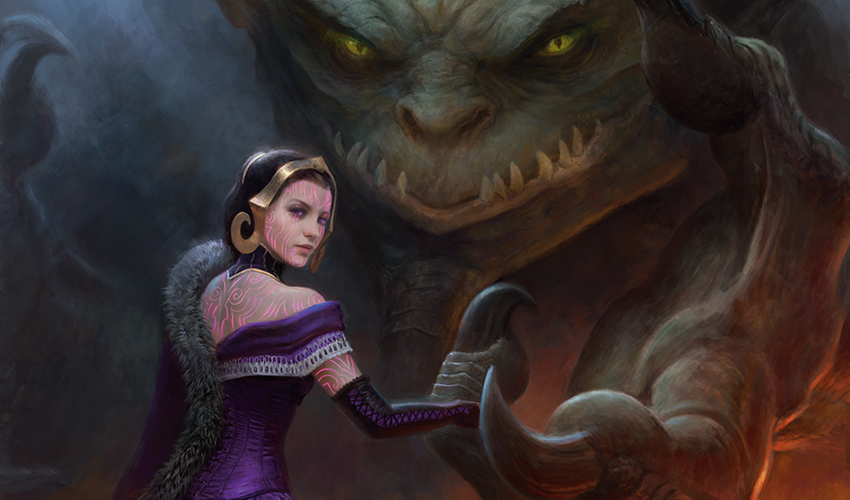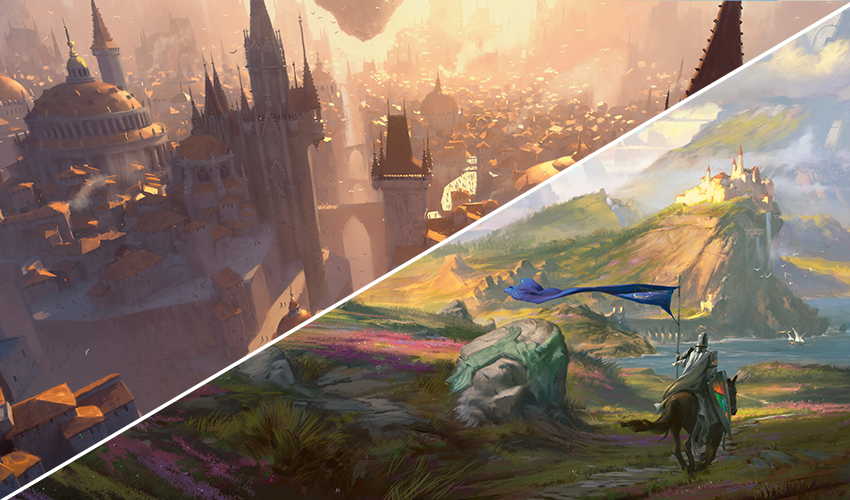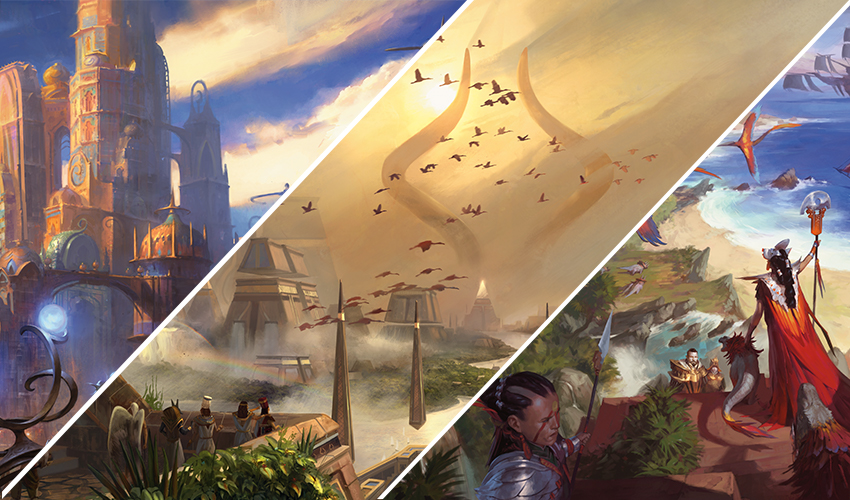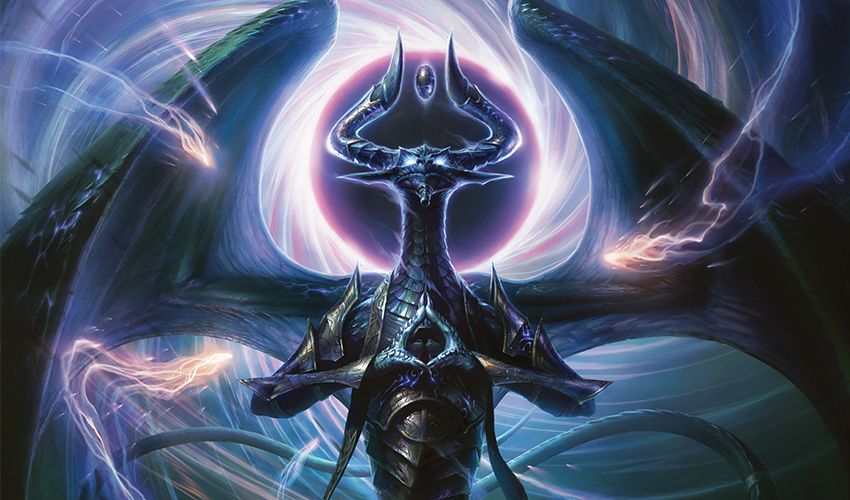The Bolas Arc, Part 1
Most often when I talk about Magic design, it's from the vantage point of creating a single set. Today's article is pulling back the camera a bit further to show how we create not a single set, but a larger canvas, in this case, the Bolas Arc (aka, the three years of sets that were the latest Nicol Bolas–focused story—from Kaladesh through War of the Spark). I'm choosing the Bolas Arc for a few reasons. One, we chose the Planes/sets for it all in one sitting, so I can walk through how we thought about how sets interact with one another. Two, as War of the Spark came out earlier this year, it allows me to talk about all the components since they're all now public. Three, it went through a bunch of interesting changes along the way, which makes for a cool story.

The Day of Planning
We begin our story with an offsite that a number of R&D folk made many years ago. The plan was for us to settle on six Planes for the three-year story arc. Remember, this was at the time of our two-and-two model where each year had two blocks consisting of a large set and an accompanying small set. Prior to this meeting, we had made what we had expected to be a two-year story arc about the founding of the Gatewatch on Zendikar that was then followed up by an adventure on Innistrad, all interacting with the Eldrazi (Magic Origins, Battle for Zendikar, Oath of the Gatewatch, Shadows over Innistrad, and Eldritch Moon). When we shifted from our large-small-small-core model to our large-small-large-small model, that story got condensed down to just over a single year.
Doug Beyer had spent some time working on the next story arc, something a bit more adventuresome in its scope with Nicol Bolas as the antagonist for the Gatewatch. Doug had codenamed the story arc Handlebar (a nod to the elaborate mustache that stereotypical villains twirled in pulp movie serials of the early twentieth century). Because the nature and order of the sets would dictate a lot of the story details, Doug had created a loose outline that just hit upon the high points of the story. As I remember it, the Gatewatch learns that Bolas is up to something, goes to stop him, and gets defeated as they underestimate him. This all leads to a giant battle of planeswalkers in the final act as the Gatewatch teams up with most of the known planeswalkers to defeat Bolas.
Doug's idea was to make a larger story arc than we had done in a long while (not since the Weatherlight Saga). It would reintroduce Nicol Bolas as a villain and allow us to show how dangerous he is up close—rather than behind the scenes, after the fact—as he was most often used. Doug also liked the idea of ending with a giant event, something that would feel grandiose. All the details, though, were left open to accommodate the sets/Planes we used.
Aaron Forsythe led the meeting. He said the goal was to have half of the six blocks be returns and the other half be new worlds. He also wanted to make sure that each world we chose was exciting in a vacuum. Yes, it needed to click together into the larger storyline, but most importantly, it had to be something we felt players would adore. For each world, Aaron wanted a creative conceit and a mechanical conceit. The latter was primarily left up to me.
Here's how Aaron wanted to run the meeting. We were going to first talk about returns and get a list of all the possible choices we had. We would then rank them. Next, we would talk about new worlds and get all the possibilities for those, then rank them. After we had both ranked lists, we would see how everything came together.
The goal of this meeting was to pick six blocks we had confidence in. Once we were done, we'd do some work on each (both creatively and mechanically) and eventually we'd pitch it to upper management to get an official thumbs up on the whole plan.

The Returns
We started with the returns because that was the easier half of the task. Here were all our choices, in order of their first appearance:
Dominaria – We hadn't been back to Dominaria in over a decade. I talked about how the enfranchised players frequently asked when we'd return there, as Magic had spent most of its early years on Dominaria. The Creative team explained that the main challenge of a return for them was that Dominaria had been represented in so many ways; it was ice world, jungle world, mutation world, post-apocalyptic world. Modern Magic Planes have a singular identity. It would be very tricky to capture the essence of Dominaria while making it align with a modern Plane identity. My concern mechanically was that while we had ten years to borrow from, they were all early Magic, meaning that we've already repeated the good stuff and the rest isn't all that great. Like the Creative team, trying to mechanically capture the sense of the world would be hard, as players don't think of Dominaria as one singular thing. We all recognized, though, that we would get a big response from the enfranchised community if we returned there, so it was worth figuring out.
Rabiah – This was the top-down Arabian/Persian-inspired Plane that Richard Garfield created. There hadn't been any worldbuilding, though, as Richard mostly used the original source material for direct inspiration. Maybe one day, we'd create our own top-down world inspired by the source material, and maybe we'd call it Rabiah, but it wasn't really a return in that there wasn't much creative or mechanical work to build upon, making it in many ways, more of a new Plane than a return.
Ulgrotha – This is the Plane of Homelands. Other than a small minority of diehard older players, we don't get asked much about returning to this world. The creative was a hodgepodge inspired by elements players liked from Limited Edition (Alpha)—Serra Angel, Sengir Vampire, Hurloon Minotaur, etc. It also was, in my opinion, the worst-designed set in the history of the game. There just wasn't a lot to return to.
Rath – This is the Plane from Tempest. In the Weatherlight Saga, it was overlaid onto Dominaria during the Phyrexian invasion. This meant anything we want from Rath, we could do in a Dominaria set.
Mercadia – This is the world from Mercadian Masques. Of all the Planes Wizards has made (so I'm not counting Rabiah), this is the one I get asked about the least. It was a mercantile Plane with a city element. Nothing about it really stands out and I'm not sure there's much there creatively or mechanically to build upon.
Mirrodin – We'd already returned in Scars of Mirrodin block which, at the time of this meeting, wasn't all that long ago. Also, Mirrodin had become New Phyrexia, which was intertwined heavily with the Phyrexians, and that wasn't something we wanted as part of the Bolas Arc.
Kamigawa – This is the Plane inspired by Japanese mythology. This was another Plane that I got some asks about from enfranchised players, but Champions of Kamigawa block sold horribly and received the worst reviews of any Plane since we began doing market research on them. A return here would be a pretty hard sell to upper management.
Ravnica – This is one of the most popular Planes Magic has. It's a two-color factioned Plane with ten guilds. We'd already revisited this once in Return to Ravnica block, which wasn't all that long ago. If we returned, it would have to be late in the story. As we'll get to below, Doug's storyline was eying Ravnica as the setting for the ending.
Lorwyn/Shadowmoor – This was the Plane based on Celtic mythology that bounced between a light version and a dark version of the world. Like Kamigawa, it has a fervent but small fan base. The block hadn't done all that well, and the Plane scored second worst after Kamigawa in market research on players' opinions of the world. This would be another hard sell to upper management.
Alara – This was a world made up of five shards, each comprising three consecutive colors on the color wheel. It's a factioned set with a three-color theme. Creatively, we had done what we'd often done on Planes in the past, which was blow up the core premise later in the block; the five shards had started merging. It would require some creative work to get the Plane back to the cool part, but we felt it was doable. Mechanically, the five shards each had a clear identity. The challenge would be finding ways to make overlapping colors work together synergistically, something the original Shards of Alara block hadn't executed on all that well. From a mechanical standpoint, three-color sets have some challenges, but having just done Khans of Tarkir block, we felt aware of the issues we needed to work on.
Zendikar – We'd just returned the previous year in Battle for Zendikar block.
Innistrad – We'd also just returned here in the previous year in Shadows over Innistrad block.
Theros – This is our Greek mythology–inspired Plane. At the time of this meeting, it was pretty recent.
Tarkir – This was our warlord Plane inspired by various parts of Asia. Khans of Tarkir block was also very recent at the time of this meeting, so it was too soon to return.
Then it came time to rank them. First, we pulled all the sets we felt were too soon to return to inside this three-year window. That removed Zendikar, Innistrad, Theros, and Tarkir. We also removed New Phyrexia, as it was too tied to the Phyrexians and we didn't want them playing a role in this story. Rath was removed as a separate Plane as it was now part of Dominaria. Here's how we ranked the rest (to the best of my knowledge):
- Ravnica (but only in the third year)
- Dominaria
- Alara
—
- Lorwyn/Shadowmoor
- Kamigawa
—
- Ulgrotha
- Mercadia
- Rabiah
Ravnica was first on our list because of some story needs. I'll talk about this later, but we were aware of a probable need for Ravnica in the finale. Dominaria was next as we were excited by the idea of a return, fully aware that we were signing ourselves up for a challenging execution. Alara was third, as we felt a return would excite players but acknowledged that there was a bunch of work that had to be done creatively and mechanically to clean up issues from our last visit. Lorwyn/Shadowmoor and Kamigawa were next on our list, but both with a bit of a gap from our first three choices. These are Planes beloved by a vocal—but highly enfranchised—minority. Navigating the cool parts of each without repeating the mistakes that doomed them in their first appearance would be an undertaking, one that would be a challenge to get a green light on. Ulgrotha, Mercadia, and Rabiah were the underdogs without much championing by anyone.

The New Planes
For this part of the meeting, we went through a bunch of ideas for new Planes. First, the Creative team presented ideas they'd come up with. Knowing this meeting was on the books, the Creative team asked all its members to create one or more new Plane ideas. The Creative team then talked about all the ideas and presented their top ones at this meeting. Next, I gave a presentation about all the Planes that the playerbase had been asking for. I often ask my followers questions on social media, and one of them I'd posted was about what new Planes they wanted to see. I collected that data and presented it at this meeting along with the anecdotal data I'd collected over years of players talking to me. Finally, I talked a little bit about some mechanical ideas I had for Planes. Some of the ideas were tied to existing proposals, but a few were mechanics without a home.
This section is a bit trickier to talk about because some of the ideas that didn't make it here are ones you all will see in the future. For example, this is one of the numerous places I pitched Fairy-Tale World to almost no fanfare. I'm going to talk about the three settings that made it to the top of our lists. When I tell the story about the next batch of Planes we chose, I can talk about how some of them came from this meeting.
Kaladesh
In Magic Origins, we decided to visit the home Planes of each of the five original Gatewatch members. Only Nissa's home Plane, Zendikar, was known at the time. The Creative team spent a lot of time on figuring out the other four. It was decided that Liliana was from Dominaria and Gideon was from Theros. (We figured the latter out just in time to sneak an Easter egg in Journey into Nyx on the card Desperate Stand). Jace's home Plane was chosen as Vryn, a world we'd only seen hinted at on a plane card from Planechase. Chandra, though, required a brand-new Plane.
Chandra's outfit, complete with her regulator, had a feel of technology to it. The idea of a steampunk-inspired set had been floating around for years. Chandra's name implied some Indian influence (the idea of Chandra being mixed race was something we'd talked about for years), so all that together inspired a brand-new Magic plane, one with a tie to invention. The Magic Origins Creative team was on the hook for creating enough of Kaladesh to show it off on cards. The more they worked on it, the more they really liked what they were making. Mid-set, the decision was made to put more resources into it because we felt like we could make this a throw forward to a Plane we could visit in a Standard-legal set.
As such, this was the one new Plane we had kind of committed to before walking into this meeting. We didn't want to wait more than three years to see it, as it would squander the goodwill Magic Origins had created for the setting. We didn't know where in the three years we were going to put it, but we all agreed we were interested in using it.
Ixalan
About every third year, all of Magic R&D has an all-day offsite where we talk about the future of Magic. One of the things we normally do is set aside the morning for a bunch of micro-talks. A micro-talk is a 5-minute presentation where any member of R&D can talk about any topic they wish. It was during a micro-talk that Jenna first pitched her idea of the Plane of Ixalan. It was a Meso-American-inspired setting where the invaders were Vampire conquistadores. It was envisioned as a two-sided conflict between the invaders and the inhabitants of the world.
The audience liked the pitch and gave Jenna a bunch of notes. When it came time to present Planes to the Creative team, Jenna presented a more polished version of the set. It was one of the Planes chosen to be presented at this meeting. Jenna had gotten some help from other team members and had compiled a lot of source material to show what the environment would look like. It was selected because the Creative team was passionate about it and we felt it could be visually stunning. At the time, it had zero mechanical identity.
Amonkhet
When I did my talk about what the audience had been asking for in new Planes, an Egyptian mythology–inspired set was at the top of the list. It had also been something R&D had talked about for a long time. For example, when we decided that Champions of Kamigawa block was going to be a top-down design, we'd looked at a list of candidates, and Japanese barely beat out Egyptian. It was a Plane theme that often came up, but not one we'd ever chosen to do. When I presented that it was the top choice of the players, it was clear to the room that it was finally time to give it a shot.
There were a few questions that had to be answered. One, Egyptian mythology is just lesser known than Greek mythology to most of our audience. Were there enough top-down things to work with? Two, how do we make it a Magic Plane? Yes, there would be all the things the audience would expect from an Egyptian setting, but how would we make feel our own? Three, Jeremy Jarvis pointed out that there are two different takes on Egypt—sunny, living Egypt where the civilization is alive, and dark, dusty Egypt where we're digging through tombs learning about the civilization long after it's died. We would have to pick a path, and that meant that some tropes might be left out of the set.
When we were done, we made a ranking of all the new worlds. Of these three, I believe they were:
- Kaladesh
- Ixalan
- Amonkhet
The room was well aware, though, that Amonkhet would be a much easier sell to upper management than Ixalan.

The Choosing of the Blocks/Worlds
The next part of the process had us write up the following on the white board:
Block #1:
Block #2:
Block #3:
Block #4:
Block #5:
Block #6:
We then looked at our ranked list and decided what should go where. The first thing was brought up by Doug. Block #6 had some requirements we needed to address from a story level. We wanted a big battle between Bolas and Gatewatch and friends. Doug felt strongly that the battle needed to be on a known and popular world. Part of what will make the war feel more grandiose is the idea that the players had something at stake too—a Plane they loved was in jeopardy. New Phyrexia was out for story reasons, so that left Ravnica, Innistrad, Zendikar, and, possibly, Dominaria. Ravnica seemed like the best choice. If it was in the third year, it would be over seven years since we'd been there. It was a short window, but we felt probably enough for Ravnica. We quickly talked through the other options, but Ravnica seemed the clear choice.
This brought up a different issue. The final block was going to be about the war with Bolas. How would players feel if we returned to Ravnica and didn't have a guild-focused set? The thought was that they'd be unhappy. What if we returned in the fifth block and gave them a guild set and then stayed on Ravnica for the sixth block, which would be about the war? We liked the idea, but knew it would be a bit controversial inside the building as the whole reason for the change to the two-and-two model was to not spend one year all on the same Plane. The idea was to introduce the concept of an event block and sell it as something that's less focused on the Plane and more about a big thing that's happening. (I'll talk more about this next week in Part 2.)
So, the first thing we wrote on the board was this:
Block #1:
Block #2:
Block #3:
Block #4:
Block #5: Ravnica (Guild block)
Block #6: Planeswalker War (on Ravnica)
The next thing that got brought up was that Block #4 was going to be during the summer of Magic's 25th anniversary. We'd really underplayed Magic's 20th anniversary and wanted to do right by the 25th. A return to Magic's original home felt like a perfect opportunity to play into the nostalgia of the anniversary. Yes, it would mean three new-world blocks followed by three return blocks, but we'd just had a whole year of returns with Battle for Zendikar and Shadows over Innistrad blocks, so three new worlds in a row felt okay.
Block #1:
Block #2:
Block #3:
Block #4: Return to Dominaria
Block #5: Ravnica (Guild block)
Block #6: Planeswalker War (on Ravnica)
We decided to go with our top three ranked choices for the new Planes, so all that was left was to put them in an order. As we didn't have a clear sense of their mechanical identities, we decided to push that off to later in the day. Here was the order:
Block #1: Kaladesh, Ixalan, or Amonkhet
Block #2: Kaladesh, Ixalan, or Amonkhet
Block #3: Kaladesh, Ixalan, or Amonkhet
Block #4: Return to Dominaria
Block #5: Ravnica (Guild block)
Block #6: Planeswalker War (on Ravnica)
Anyway, we had our rough list. The next task was to kick the wheels and make sure that all our choices would add up to a successful total package for us to shop around the building. This meant that the Creative team had to ensure each Plane had enough to build a world around, and I had the task of making sure that each world had an overall mechanical identity. Block #5? No problem. Block #3? I'd have to think about it.
We're out of time for today, so our story will continue next week. I'm curious how you're enjoying this look at a different part of the process. You can email me or contact me through any of my social media accounts (Twitter, Tumblr, and Instagram).
Join me next week for Part 2.
Until then, may you make your own plans for the future.
#683: Throne of Eldraine Stream
#683: Throne of Eldraine Stream
38:27
In this podcast, I take listeners behind the scenes into the making of the Throne of Eldraine announcement stream.
#684: Throne of Eldraine
#684: Throne of Eldraine
40:32
In this podcast, I talk about the design of Throne of Eldraine.
- Episode 682 Connecting Set & Story
- Episode 681 Math in Magic
- Episode 680 Diversity in Game Design

